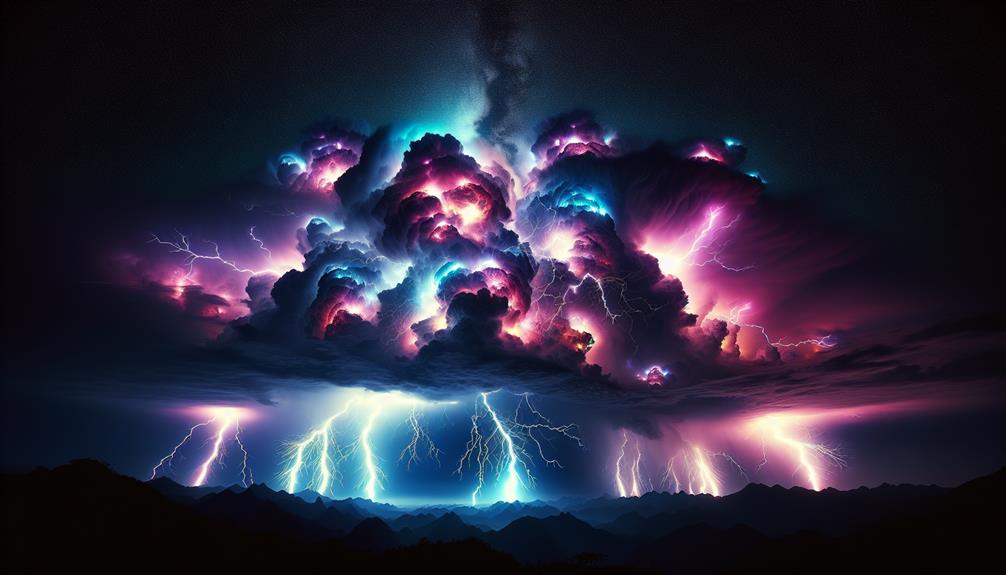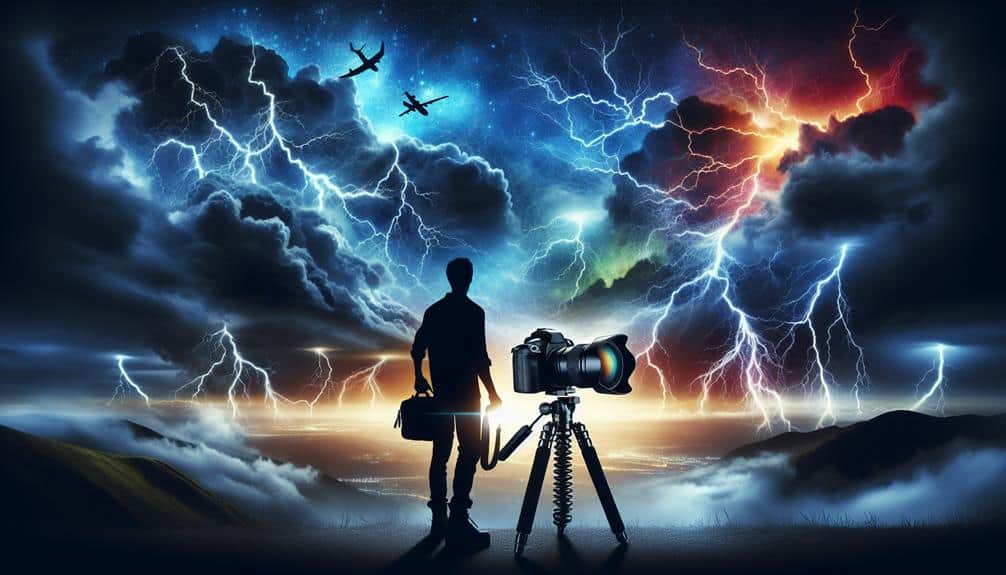Capturing lightning requires advanced techniques because of its unpredictable and intense nature. We must comprehend weather patterns and utilize real-time maps to time our shots effectively. Essential gear like lightning sensors, sturdy tripods, and wide-angle lenses guarantees our photos are both precise and secure. Manual camera settings are crucial for managing exposure, aperture, and ISO to capture clear, detailed lightning strikes. Safety measures, such as selecting protected locations and monitoring storms with reliable apps, are essential. Post-processing enhances clarity and impact, preserving the natural beauty of lightning. With these methods, we tap into the potential for truly stunning lightning photography.
Key Points
- Advanced techniques ensure precise timing to capture fleeting lightning strikes.
- Proper equipment and settings mitigate noise, enhancing image quality.
- Strategic positioning increases safety and maximizes photographic opportunities.
- Understanding storm patterns aids in predicting and capturing dynamic lightning events.
Understanding Lightning Behavior
To effectively capture lightning, we must first analyze its unpredictable behavior and the atmospheric conditions that generate it. Lightning photography tips emphasize the importance of understanding weather patterns. We need to monitor weather forecasts and identify conditions favorable for lightning, such as warm, moist air rising rapidly, often associated with thunderstorms.
Studying lightning strike locations is pivotal. Historical data and real-time lightning maps provide insights into where strikes are most common. Storm chasing techniques come into play here; we must be prepared to position ourselves strategically without compromising safety. We should prioritize areas with a high frequency of lightning activity, like mountainous regions or open plains.
Timing is everything in lightning photography. We should focus on the development stages of a storm, typically when the updrafts and downdrafts are most intense. By correlating these stages with our observations of weather patterns, we can better predict when and where lightning will strike.
Equipment and Gear Essentials
Capturing lightning necessitates a combination of specialized equipment and a thorough understanding of photographic techniques. To successfully photograph lightning, we need to carefully select our gear to guarantee precision and reliability. Let's explore the necessary equipment for this thrilling pursuit.
Firstly, lightning sensors are vital. These devices detect lightning and automatically activate the camera's shutter, making sure that we capture the momentary occurrence of a lightning strike. Without them, timing the shot would be nearly impossible.
Secondly, distant cameras allow us to position our equipment in various locations while maintaining a safe distance. This not only improves our safety but also gives us the freedom to experiment with different angles and perspectives without being physically present near the storm.
Finally, a robust tripod is essential for stabilizing our camera. Given the long exposure times often required for lightning photography, any slight movement can result in blurred images. A dependable tripod lessens this risk, guaranteeing sharp, clear shots.
In summary, our essential gear comprises:
- Lightning sensors for precise timing.
- Distant cameras for flexibility and safety.
- A sturdy tripod for stability.
Camera Settings for Lightning
With our equipment in place, we now need to fine-tune our camera settings to optimize the capture of lightning strikes. Let's start with the exposure settings, which are essential for balancing light and detail. We should set our camera to manual mode, giving us full control over shutter speed, aperture, and ISO.
Shutter speed plays a pivotal role in capturing lightning. We recommend starting with a 15-30 second exposure. This duration increases the chances of catching a lightning bolt within a single frame.
For aperture, an f/8 to f/11 setting provides a good balance between depth of field and sharpness.
Next, consider ISO settings. Keeping the ISO low, around 100-200, minimizes noise and maintains image quality.
When it comes to composition, use a wide-angle lens to capture the expansive sky and landscape, enhancing the drama of the lightning strike.
Safety Precautions in Storms
Our priority in lightning photography must always be safety, as storms can be unpredictable and hazardous. We need to adopt thorough risk management strategies to mitigate potential dangers. Lightning strikes pose significant risks, so it's important to stay informed and prepared.
Let's outline necessary safety measures.
- Location Assessment: Choose a shooting location that offers protection. Avoid open fields, tall trees, and metal structures. A car can serve as a safe haven due to its Faraday cage effect.
- Emergency Procedures: Have a clear plan in case the storm intensifies. Know the nearest shelter and communicate your plans to someone who can assist if needed. Carry essentials such as a first aid kit, water, and a charged phone.
- Weather Monitoring: Utilize reliable weather apps and updates to track storm progression. Understanding radar data and storm patterns is essential for making informed decisions.
Post-Processing Techniques

Post-processing lightning photos demands meticulous attention to detail to enhance the dramatic impact and clarity of each shot.
We start by addressing color correction to guarantee that the lightning strikes maintain their natural hue, often a sharp blue or white. By adjusting the color balance, we can make the lightning stand out against the darker tones of the stormy sky.
Noise reduction is essential, especially since lightning photography frequently involves high ISO settings. By applying noise reduction techniques, we can eliminate unwanted graininess without sacrificing image detail. This step is vital to maintaining the crispness of the lightning bolt.
Exposure blending allows us to combine multiple exposures of the same scene to achieve a balanced image that highlights both the lightning and the surrounding landscape. This technique helps in capturing the full dynamic range of the scene, ensuring no details are lost in the shadows or highlights.
Frequently Asked Questions
How Does Location Impact the Chances of Successfully Capturing Lightning?
The location's geographic impact directly affects our lightning success. Terrain influence plays a pivotal role in determining lightning photography opportunities. Flat, open areas increase visibility, while mountainous regions may obstruct views, reducing our chances of successful captures.
What Are Some Common Mistakes to Avoid When Photographing Lightning?
When photographing lightning, let's not forget composition tips and exposure settings. We need to balance equipment requirements with safety precautions. Avoid common mistakes like improper framing, incorrect shutter speed, or ignoring storm safety guidelines. Stay free, stay safe.
Can Mobile Phones Be Effectively Used for Lightning Photography?
We can use mobile phones for lightning photography, but their limitations in shutter speed and sensor size often hinder quality. Alternative equipment, like DSLRs or mirrorless cameras, offers better control and results for capturing lightning effectively.
How Do Weather Patterns Influence Lightning Photography Opportunities?
Imagine this: we're storm chasers from the future. Seasonal variations and atmospheric conditions directly influence our lightning photography opportunities. We strategize based on weather patterns, ensuring we capture nature's electrifying displays with precision and freedom.
What Role Does Timing Play in Capturing the Perfect Lightning Shot?
Timing is essential in capturing lightning. We must synchronize our camera settings and composition with the storm's activity. Proper equipment and thorough preparation guarantee we're ready to seize the fleeting moment when lightning strikes.


